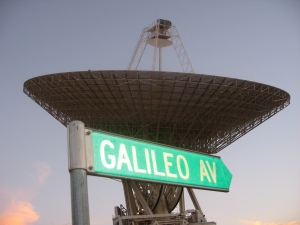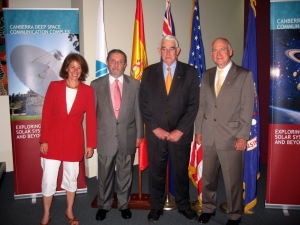 The final data has been collected and the main observation campaign has come to a close, but now the real work of the Jupiter: Project 24 effort begins – seeing what the data will tell us about the ‘king of the planets’.
The final data has been collected and the main observation campaign has come to a close, but now the real work of the Jupiter: Project 24 effort begins – seeing what the data will tell us about the ‘king of the planets’.
Ultimately, the project followed Jupiter for over 30 hours and collected excellent data through all three stations in NASA’s Deep Space Network.
For the radio astronomy teams the real work begins, unravelling the data, reviewing the results and submitting their findings for peer review before a final science paper is published.
The J:P24 campaign was designed to both mark the 400 years since Galileo used his telescope to first observe Jupiter and make a valuable contribution to the International Year of Astronomy 2009 (IYA09). It was also an opportunityto highlight the international cooperation that exists in space exploration and radio astronomy. A partnership that goes back over more than 50 years between the United States, Australia and Spain.
J:P24 was also an opportunity to use the internet and show radio astronomy ‘in action’. Through the Twitter page and this website images, data and live commentary were shared with a global audience. Several thousand people followed along, watching each antenna move into position, see data plots appear on their screen and take a look inside some of the operational areas.
This may well have been a first for this type of campaign and highlights the level of ‘active’ interest from the general public for science when it is made accessible.
During IYA09, involving the public and inspiring a new generation of scientists and explorers was a prime goal. The use of students at some of the stations to assist in the collection of the data was another important achievement of the J:P24 campaign.
There is still much to do and the radio astronomers will be busy working on their reports. It is hoped that a final paper will be released before the end of the year at the close of IYA09. Once published, the science paper will also be released through this website – so keep checking back.
J:P24 may be over, but now the real work begins!
 Today I gave a talk about the project at the Center for Astrobiology (CSIC-INTA), hosted by PARTNeR. All the students and teachers in the classroom for the PARTNeR observation came. I was so impressed with lots of nice questions by the students. I also appreciated the excellent PARTNeR staff (in particular, Juan Angel Vaquerizo and Jesus Santiago Perez from INTA) who arranged for all the events in Madrid to happen. At right is a photo taken after the talk with the students/teachers and PARTNeR staff.
Today I gave a talk about the project at the Center for Astrobiology (CSIC-INTA), hosted by PARTNeR. All the students and teachers in the classroom for the PARTNeR observation came. I was so impressed with lots of nice questions by the students. I also appreciated the excellent PARTNeR staff (in particular, Juan Angel Vaquerizo and Jesus Santiago Perez from INTA) who arranged for all the events in Madrid to happen. At right is a photo taken after the talk with the students/teachers and PARTNeR staff.







